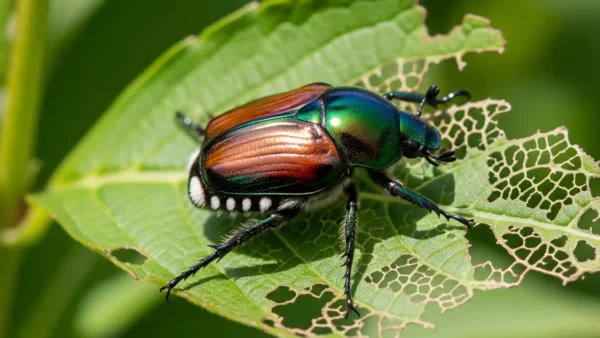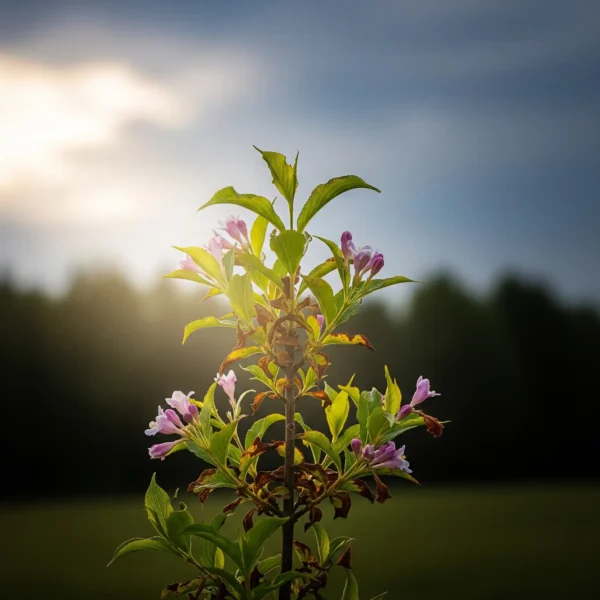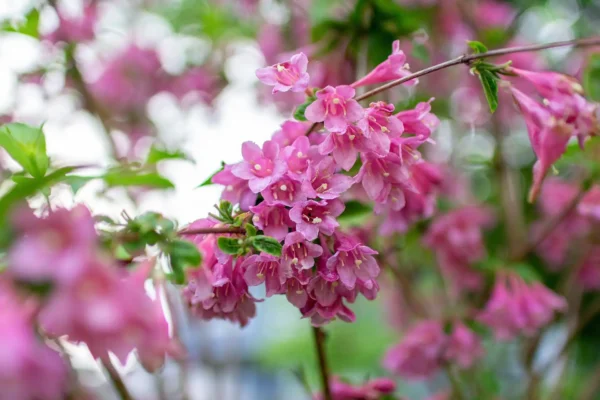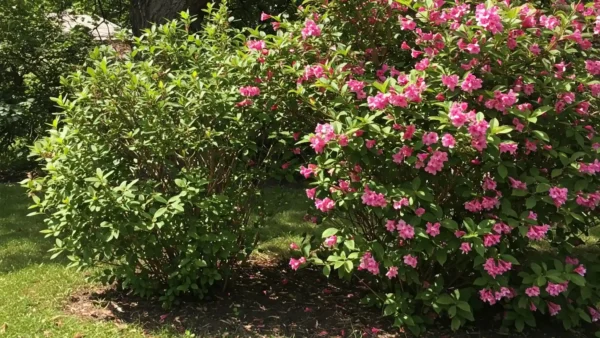How to Fertilize Weigela for Lush Growth & Abundant Blooms (A Stage-by-Stage Guide)
Dreaming of a Weigela that’s an absolute cascade of vibrant, trumpet-shaped flowers and lush, healthy foliage? I certainly do! Although Weigelas are not often the pickiest eaters in the garden, the secret to revealing their whole, amazing potential is really providing them with the correct nutrients at the appropriate time. Still, the fertilizer industry can be rather confusing, no? When is the ideal time, what should you use, and how much is too much?
Us gardeners often find it to be a dilemma. Looking at all the figures and technical language on those bags and bottles makes you question whether you’re doing too much, too little, or perhaps the wrong thing altogether. Unfortunately, incorrect fertilization or sometimes a total lack of it when the soil is poor might produce unsatisfactory outcomes such poor growth, sparse flowering, or in some cases, even damage to your valued plant.
But do not worry! This all-inclusive book will clarify Weigela fertilization. We’ll look at their nutritional requirements at various points in their life, assist you in selecting the appropriate kinds of fertilizer, and teach you the right way to use it. The aim? To enable you to grow a really amazing shrub that will be the envy of the area!
Weigela’s Basic Appetite: Knowing Their Nutritional Needs
First things first, let’s get to know what, nutritionally speaking, drives a Weigela.
Usually Not Heavy Feeders
Weigelas are one of the nice things about them since, especially if they’re planted in fairly good, healthy soil, they are usually not very demanding bushes. This is fantastic news for gardeners of low maintenance! Over-fertilizing your Weigela, in fact, can sometimes be more damaging than somewhat under-fertilizing it. Excessive good can cause issues, which we will address later.
Weigela’s Roles for the “Big Three” Nutrients (N-P-K)
Looking at a fertilizer bag will reveal three notable figures. The N-P-K ratio is the “big three” macronutrients’ percentage of Nitrogen, Phosphorus, and Potassium. Here is a fast summary of how they benefit your Weigela:
- Nitrogen (N): Consider nitrogen as the “leaf maker.” It’s absolutely vital for strong leafy growth, proper stem development, and that beautiful deep green hue in the leaves. It is absolutely necessary for general plant vitality.
- Phosphorus (P): The “root and bloom booster,” phosphorus is quite important for robust root growth (particularly for young plants), flower production, and also for fruit and seed set (though we’re mostly interested in the flowers with Weigelas!).
- Potassium (K): Potassium (K) is the “all-around health guardian.” It promotes efficient water use, strong stems, disease resistance, general plant health, and hardiness. It enables the plant to resist stress.
Healthy Soil First: Its Significance
I cannot emphasize this enough: good, healthy soil cannot be replaced by fertilizer. Building up your soil is the first step in the best way to feed any plant, including Weigela. Rich in organic material, such as compost, soil often offers a slow, consistent supply of many required nutrients, enhances drainage, and supports good soil microorganisms. If required, fertilizer should be viewed as a supplement rather than the main fix for poor soil.
When (and When NOT) to Fertilize Your Weigela: Timing Is Everything
Success depends on applying fertilizer at the appropriate moment, much as serving a meal at the proper time.
The Best Time: Early Spring is Prime Time
The best time to apply fertilizer for established Weigelas is early spring.
The reason is? The plant is waking up from its winter dormancy and starting a phase of active growth at this time. The plant can easily absorb and use the nutrients you offer for energy, growth, and preparation for that wonderful bloom display as new leaves appear and stems lengthen.
A good guideline is to fertilize just as the leaf buds start to swell or as the first little new leaves begin to appear.
Fertilizing at Planting Time: A Careful Approach
Many gardeners question whether they should fertilize a newly planted Weigela.
It’s somewhat of a “pros and cons” scenario. Often, good soil preparation in the planting hole with plenty of compost is more than enough to get a new Weigela off to a fantastic start. The compost enhances soil structure and offers mild nutrients.
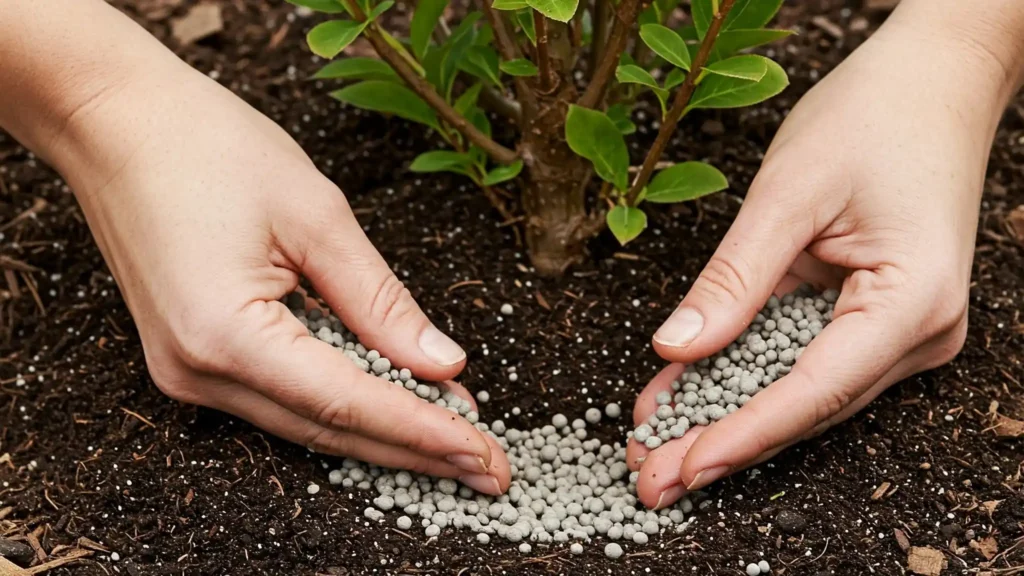
Should you decide to fertilize at planting time, be sure to be mild. Alternatively, combine some bone meal or extra compost with the backfill soil. Strong, fast-acting chemical fertilizers can easily burn the delicate new roots, so avoid using them right at planting.
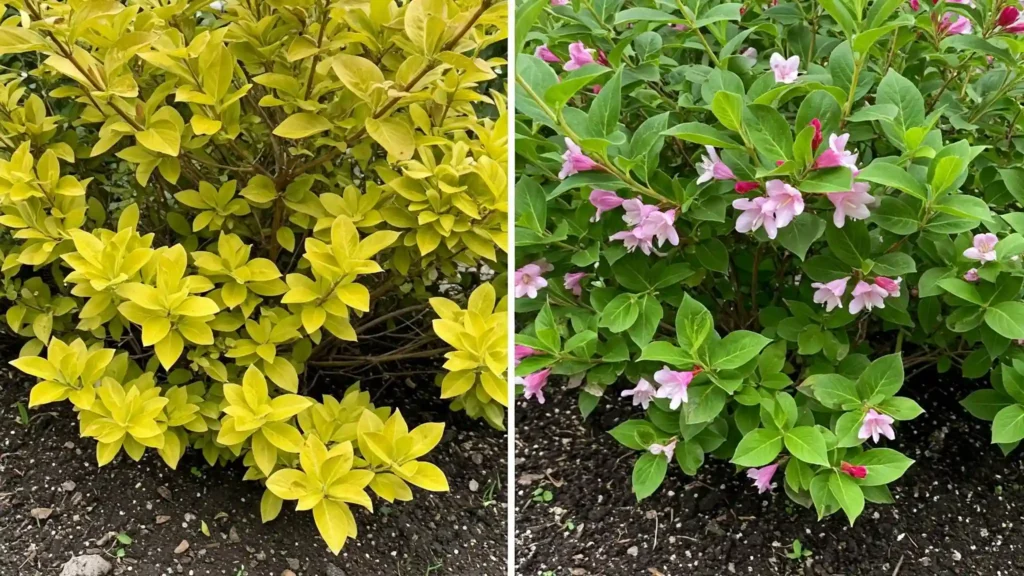
How about a mid-season boost? Usually Unneeded
A second application of fertilizer mid-season isn’t usually required for most Weigelas growing in fairly good garden soil that were fertilized in the spring. They just aren’t that hungry.
Your Weigela may be an exception to this guideline if it is growing in extremely poor, sandy soil that leaches nutrients fast or if a soil test has particularly shown a mid-season deficit that has to be fixed. Usually, it’s better to wait if the plant is healthy and developing nicely.
When NOT to Fertilize Your Weigela
Knowing when not to fertilize is equally as crucial as knowing when to do it!
- Late Summer or Fall: This is absolutely not for late summer or fall. Fertilizing your Weigela late in the growing season—usually from August onward in most areas—can encourage a flush of new, soft growth. Before the first winter frosts arrive, this new growth will not have enough time to “harden off” and mature. The outcome? That delicate new growth is very prone to cold damage and winter kill, which could set your plant back.
- During Drought or Extreme Heat: When your Weigela is stressed from lack of water or high temperatures, its capacity to absorb nutrients is compromised. Adding fertilizer now could do more damage than benefit; it could “burn” the roots or increase the stress on the plant. Before thinking about fertilizer, always make sure your Weigela is well-watered and the situation has calmed.
- When the Plant is Sick or Stressed (from other causes): Fertilizer is not medicine for a sick plant. Your Weigela needs to be diagnosed and treated first if it is exhibiting distress such yellowing leaves, wilting (despite moist soil), or dieback. Fertilizing a plant already under stress or illness can sometimes aggravate the situation.
- If Your Soil Is Already Rich and Healthy: Your Weigela may not require any extra bagged fertilizer at all if you regularly modify your soil with compost and other organic materials and it is growing strongly and flowering nicely. A soil test can be quite helpful in determining whether your soil is already supplying all your Weigela requires.
Choosing Your Weigela’s Menu: Picking the Appropriate Fertilizer
The fertilizer aisle can be quite crowded! Let’s analyze what to seek for.
Interpreting N-P-K Ratios: Knowing Fertilizer Labels
Those three figures on the fertilizer bag—e.g., 10-10-10 or 5-10-5—represent the percentage by weight of Nitrogen (N), Phosphorus (P), and Potassium (K), always in that sequence, as stated.
Like a 10-10-10, a “balanced” fertilizer has approximately equal quantities of all three.
Though higher in phosphorus, a 5-10-5 fertilizer is lower in nitrogen and potassium.
Best Fertilizer Varieties for Weigela:
These are some decent choices usually appropriate for Weigelas:
Granular fertilizer with slow, balanced release:
- Why it’s good: This is usually a great fit for Weigela-like shrubs. The term “slow-release” refers to a consistent supply to the plant over a period of weeks or months as the nutrients are released progressively. This means you don’t have to fertilize as frequently and helps to lower the danger of root burning (which can result from over-application of fast-acting fertilizers).
- N-P-K ratio examples: Search for 10-10-10, 14-14-14, or comparable balanced figures. Many all-purpose tree and shrub fertilizers qualify.
Fertilizers Designed Especially for Flowering Shrubs:
- Many times, these products are meant to help with bloom production. Phosphorus is important for flower growth, therefore they may be a little bit more in the middle number.
- For instance, you could observe a 5-10-5, 5-10-10, or a comparable ratio with the P being somewhat more noticeable.
Organic Fertilizer Alternatives:
There are several great options if you like an organic method:
- Compost and Well-Rotted Manure: The superstars of organic gardening are compost and well-rotted manure! They offer a gradual, mild release of a broad spectrum of nutrients and are great soil conditioners. Often, a Weigela in good soil only needs an annual top-dressing of compost.
- Bone Meal: Good organic source of calcium and phosphorus, bone meal helps root growth and flowering. It releases slowly. Use it if a soil test shows a need for phosphorus; otherwise, combine a little into the planting hole for new shrubs.
- Fish Emulsion or Seaweed Extracts: Fish emulsion or seaweed extracts—liquid—can offer a mild increase in trace elements and nutrients. The plant quickly absorbs them. If your plant appears to need it, they can be beneficial for providing young plants a little pick-me-up or as a supplementary feeding. Follow the directions to dilute.
Fertilizers in Liquid vs. Granular Form
You spread granular fertilizers on the soil; they are dry pellets or powders. Because they nourish the plant over a longer duration, slow-release granulars are usually preferred for shrubs like Weigela.
You dilute liquid fertilizers, which are concentrated liquids, with water and then apply them to the soil or occasionally use them as a foliar spray. Though their effects are often shorter-lived, they are usually faster-acting than granulars. They can be beneficial for container-grown plants or for providing a rapid boost.
Choosing Fertilizer by Means of a Soil Test
A soil test is the best approach to know precisely what your soil could be lacking and what kind of fertilizer—if any—is actually required, thus I will repeat it. A soil test will provide the levels of major nutrients and your soil’s pH, which influences nutrient availability. Usually, your nearby cooperative extension office can assist with soil testing kits and result analysis. Guessing might result in using pointless nutrients, which wastes money and could damage your plants or the surroundings.
Your Weigela’s Stage-by-Stage Fertilizing Guide
The age and circumstances of a Weigela will determine its nutritional needs somewhat.
Fertilizing Newly Planted Weigelas (First Year)
Your first task when planting a Weigela is to create a strong, healthy root system.
Emphasizing strong root growth instead of rushing a lot of top growth right now.
Advice:
- Often, the best and safest approach to feed a new Weigela is just to generously alter the planting hole with good quality compost.
- Should you decide to use a bagged fertilizer, apply a half-strength balanced liquid fertilizer once or twice a few weeks following planting (once it indicates new growth). When you plant, you might also combine some bone meal or a little amount of slow-release granular starter fertilizer (which usually contains more phosphorus) into the backfill soil.
- Most importantly, stay away from newly planted Weigelas with strong, fast-acting chemical fertilizers as these can readily scorch their delicate, growing roots. Here, gentleness is essential.
Fertilizing Established Weigelas (Year 2+): For Maintenance & Flowering
Generally, once your Weigela has been in the ground for a year or two and is well-established, its fertilizing needs are rather low.
Your Weigela might only require an annual top-dressing of compost each spring to maintain happiness and health if your soil is good and rich in organic content. Look at your plant; if it is thriving, has nice leaf colour, and flowers abundantly, it is most likely getting what it needs.
Should You Decide to Fertilize:
- As new growth starts in early spring, use a balanced, slow-release granular fertilizer such as 10-10-10.
- On the other hand, you might apply a fertilizer designed especially for flowering bushes, usually with a little greater phosphorus content.
- Carefully follow the package instructions on application rates. More is NOT better!
Fertilizing to Increase Blooms (If Good Care Is Not Producing Flowering)
A particular method of fertilization could help if your current Weigela is healthy but its blooming is somewhat poor and you’re confident other elements are ideal (ample sunlight, appropriate pruning timing, sufficient water).
Applied in early spring before the flower buds fully develop, a fertilizer that is somewhat higher in phosphorus (the middle number in N-P-K) could promote more plentiful blooming.
In this case, avoid excessive nitrogen as too much can encourage rich leafy growth at the cost of flowers. A large green bush without flowers is not what you want!
Fertilizing Weigelas Under Stress or Recovery
This calls for more care.
Important Warning: Do NOT fertilize a Weigela that is severely stressed by drought, overwatering (which can damage roots), disease, significant pest infestation, or recent transplant shock. The plant is already under stress; fertilizer could exacerbate it.
You may think about a really mild feeding to assist support the plant’s comeback once it obviously exhibits indications of recovery—e.g., new healthy leaves are sprouting, the wilting has ceased. A light top-dressing of compost or a half-strength balanced liquid fertilizer would be suitable. Consider it a mild tonic rather than a substantial dinner.
The Art of Application: Correctly Fertilizing Your Weigela
Choosing the correct fertilizer is only one aspect; your application of it also matters greatly.
Reading the label is mandatory!
I cannot stress this enough: Always read and follow the particular directions and application rates on the fertilizer product label. Different products have varying recommended amounts and concentrations. Applying too much might harm your plant and burn roots.
Using Granular Fertilizer:
- Measure Properly: Depending on the size of your shrub or the area to be covered, use the advised amount.
- Distribute Evenly: Distribute the granules uniformly on the soil surface around the base of the plant, extending out to the drip line—the imaginary circle on the ground directly under the outermost tips of the branches—or even slightly beyond. Most of the active feeder roots can be found here.
- Avoid Direct Contact: Try to avoid getting granular fertilizer directly on the leaves or in continual contact with the main stems or trunk of the Weigela, as this may cause burning.
- Include Gently (Optional but Good): If at all feasible, softly rake or scratch the granules into the top inch or so of soil. This helps them to touch the soil more closely and lessens their likelihood of washing away. On the other hand, use the fertilizer before you update your mulch layer.
- Water Well: Water well; this is absolutely vital! Water the area well after applying granular fertilizer. This allows the nutrients to be carried down into the root zone where the plant can access them. It also stops fertilizer burn.
Using Liquid Fertilizer:
- Dilute Correctly: Always dilute concentrated liquid fertilizers with water per the package directions. Using it unwatered could seriously harm your plant.
- Apply to Moist Soil: Usually, liquid fertilizer is best applied when the soil is already somewhat moist, not bone dry.
- Apply Evenly: Pour the diluted fertilizer solution evenly over the soil surrounding the root zone of the Weigela, out to the drip line.
Using Manure or Compost:
- Spread a Layer: On the soil surface surrounding the base of your Weigela, apply a 1-2 inch layer of compost or well-rotted manure, reaching out to the drip line.
- Keep Away from Stems: Like with granular fertilizer, keep the organic matter a few inches away from the main stems or trunk to allow for good air circulation and prevent possible rot.
- Incorporate Lightly (Optional): You may softly work it into the top inch of soil if you wish, or just let rain and earthworms do the job of incorporating it over time.
Too Much of a Good Thing: Over-Fertilization Symptoms in Weigela
Certainly, you can over-fertilize your Weigela, which could create major issues. Be on the lookout for these indicators:
- Burnt Leaf Edges or Tips: The leaf edges or tips could become brown, dry, and crispy.
- Wilting: Even with wet soil, the plant could wither. Excess fertilizer salts harming the roots might cause this, therefore compromising their capacity to take up water.
- Excessive Leafy Growth, Few Flowers: Too much nitrogen is indicated by excessive, lush leafy growth with few or no flowers. The plant expends all of its energy creating leaves rather than flowers.
- Slowed Growth or Stunted Plants: Stem or Branch Dieback.
- Salt Build-up: A White, Crusty Salt Buildup on the Soil Surface or around the rim of pots.
How to handle suspected over-fertilization:
- Stop Fertilizing: Cease fertilizing right away.
- Remove Excess (if possible): Should you still see granular fertilizer, try to carefully scrape away as much as you can.
- Leach with Water: Deeply and often water the area (if your soil has good drainage). This tries to “leach” or flush the surplus fertilizer salts down through the soil and away from the root zone. This might have to be done multiple times spread out over a few days.
Beyond Bagged Fertilizer: The Strength of Organic Matter
Though commercial fertilizers have their uses, always value the amazing advantages of good old-fashioned organic matter for nourishing your Weigela and enhancing your soil.
The Black Gold of the Gardener: Compost
I call it “black gold” for a purpose! One of the finest additions to your garden soil is compost.
- Nutrient Release: Decomposing, it gradually feeds your plants softly over time by releasing a broad spectrum of vital nutrients.
- Soil Improvement: Whether your soil is sandy (it helps retain moisture and nutrients) or heavy clay (it helps enhance drainage and aeration), it significantly enhances soil structure.
- Microbial Life: It promotes a good population of useful soil bacteria, which are essential for nutrient cycling and plant health.
More than simply a lovely topping, mulch
Many organic mulches are more than simply attractive and weed-suppressing.
- Nutrient Contribution: Organic mulches such as wood chips, shredded bark, or leaf mold slowly decompose and add useful organic matter and nutrients to the soil below as they age.
- Other Benefits: Mulch helps to maintain soil moisture (so you should water less frequently), prevents weeds (which rob nutrients and water), and controls soil temperature (keeping roots cooler in summer and warmer in winter).
Feeding for a Thriving Weigela: Final Thoughts
Feeding your Weigela doesn’t have to be difficult! Understanding a few fundamental ideas will enable you to confidently offer the correct diet to support your Weigela. Keep in mind that Weigelas are not particularly heavy feeders; usually, the ideal basis is good soil rich with organic content. Should you decide to apply commercial fertilizers, early spring is often the ideal time; picking a balanced, slow-release formula or one made for flowering shrubs is a smart idea. A soil test can always help you make decisions!
Thoughtful feeding will help your Weigela to reward you with robust growth, good, bright leaves, and, naturally, a stunning show of its characteristic trumpet-shaped flowers that will delight your garden year after year. Enjoy fertilizing!
FAQ Area (To Improve User Experience and SEO)
Must I yearly fertilize my Weigela?
Not really. Your Weigela may not require extra bagged fertilizer every single year if it is thriving, has rich leaf color, and blooms abundantly in soil already fertile or routinely amended with compost. Your best guide is the performance of your plant. A soil test can also let you know whether fertilization is required.
For Weigela, what’s the ideal N-P-K ratio?
Usually, a balanced ratio like 10-10-10 (or comparable, like 14-14-14) is quite acceptable for general upkeep of an established Weigela in suitable soil. A fertilizer with a little greater phosphorus (P) content, such as a 5-10-5 or 5-10-10, applied in early spring, would help if your plant is otherwise healthy and you are particularly trying to promote more blooms. What your particular soil test findings show will also help to determine the ideal ratio.
May I use an all-purpose garden fertilizer for my Weigela?
Yes, in many cases, a good quality, general-purpose, balanced (e.g., 10-10-10) slow-release granular garden fertilizer is usually quite appropriate for Weigelas. Just be sure to follow the product label’s application rates.
My Weigela’s leaves are yellow. Will it be fixed by fertilizer?
The underlying reason of the yellow leaves will determine much. The correct fertilizer could help if the yellowing is caused by a real nutrient deficit in the soil the fertilizer can handle; for example, a lack of iron in soil that isn’t too alkaline, or a general lack of nutrients. Overwatering (causing root rot), underdraining, wrong soil pH (which can “lock up” nutrients like iron, rendering them unavailable to the plant), pest issues, or diseases can also cause yellow leaves on a Weigela. Often, fertilizing a plant stressed by these other concerns makes matters worse. First, attempt to identify the underlying cause of the yellowing.
When can I fertilize a new Weigela after planting?
Usually, with fertilizing brand new plantings, caution is best. Often, adding a good amount of compost into the planting hole gives all the first nutrients a new Weigela requires. Should you wish to use a bagged fertilizer, it’s usually advised to wait several weeks to a month following planting to let the roots settle in and begin growing before using a mild, slow-release granular fertilizer. Sometimes, a very dilute liquid fertilizer—such as fish emulsion at half strength—can be applied a little earlier to provide a mild nudge. Steer clear of fast-acting, strong chemical fertilizers right at planting.



